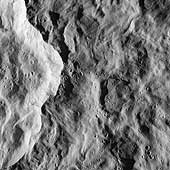|
COMETS EARTH JUPITER KUIPER BELT MARS MERCURY METEORITES NEPTUNE OORT CLOUD PLUTO SATURN SOLAR SYSTEM SPACE SUN URANUS VENUS ORDER PRINTS
PHOTO CATEGORIES SCIENCEVIEWS AMERICAN INDIAN AMPHIBIANS BIRDS BUGS FINE ART FOSSILS THE ISLANDS HISTORICAL PHOTOS MAMMALS OTHER PARKS PLANTS RELIGIOUS REPTILES SCIENCEVIEWS PRINTS
|
Related Document
Download Options
In the nick of time, the Cassini spacecraft snapped this image of the eastern rim of Saturn's moon Rhea's bright, ray crater. The impact event appears to have made a prominent bright splotch on the leading hemisphere of Rhea (see PIA06648). Because Cassini was traveling so fast relative to Rhea as the flyby occurred, the crater would have been out of the camera's field of view in any earlier or later exposure. The crater's total diameter is about 50 kilometers (30 miles), but this rim view shows details of terrains both interior to the crater and outside its rim. The prominent bright scarp, left of the center, is the crater wall, and the crater interior is to the left of the scarp. The exterior of the crater (right of the scarp) is characterized by softly undulating topography and gentle swirl-like patterns that formed during the emplacement of the large crater's continuous blanket of ejecta material. Numerous small craters conspicuously pepper the larger crater's floor and much of the area immediately outside of it. However, in some places, such as terrain in the top portion of the image and the bright crater wall, the terrain appears remarkably free of the small impacts. The localized "shot pattern" and non-uniform distribution of these small craters indicate that they are most likely secondary impacts -- craters formed from fallback material excavated from a nearby primary impact site. Because they exist both inside and outside the large crater in this image, the source impact of the secondary impacts must have happened more recently than the impact event that formed the large crater in this scene. This is one of the highest-resolution images of Rhea's surface obtained during Cassini's very close flyby on Nov. 26, 2005, during which the spacecraft swooped to within 500 kilometers (310 miles) of the large moon. Rhea is 1,528 kilometers (949 miles) across and is Saturn's second largest moon, after planet-sized Titan. The clear filter image was acquired with the wide-angle camera at an altitude of 511 kilometers (317 miles) above Rhea. Image scale is about 34 meters (112 feet) per pixel. |
